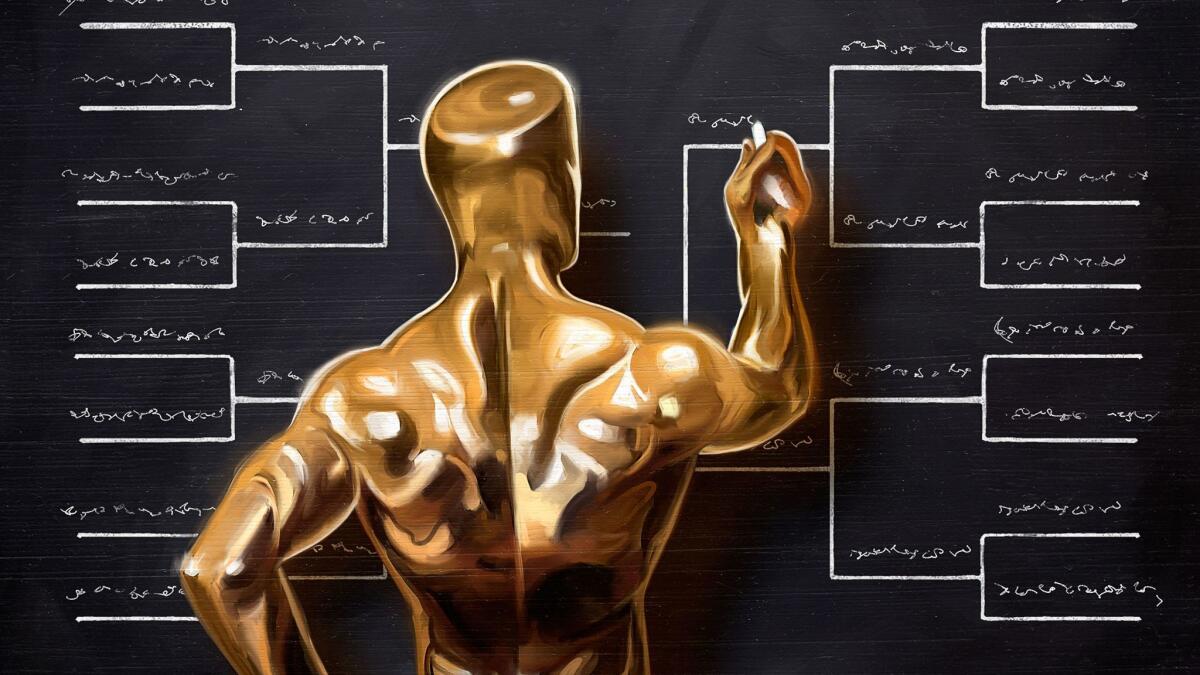Solution to the Oscar blahs: brackets!

Short of staging another best picture fiasco, how can the Academy of Motion Picture Arts and Sciences bolster the television ratings for its tired Oscar awards ceremony?
In a word: Brackets!
Why not pair America’s love of the movies with its unbridled passion for gambling? It’s a strategy that has worked wonders for the NCAA basketball championship; it could pay even bigger dividends for the Oscars.
Back in the 1980s, the awards ceremony and the hoops final used to be on the same night, but in the past 30 years, their respective ratings have gone in opposite directions. Despite the drama of the best picture flub, last year’s telecast drew just 32.9 million viewers, the lowest total in nearly a decade. That number still dwarfs the ratings for the NCAA Championship Game, but the cumulative total of all 67 games leading up to the finals is a gold mine so large it has to be split among four different networks.
Every March, millions of folks who don’t know the difference between Utah and UTEP become deeply engrossed in those schools’ field goal percentages and their strength of schedule.
They do so not because they care about the grace of a well-executed pick and roll, the efficiency of the triangle offense or the strategic use of the full-court press but because of the riches they can reap by filling out their tournament brackets most accurately.
The academy needs to do likewise. Sure, people already have Oscar pools, but those come and go with the Sunday night ceremony. Brackets, on the other hand, would drum up interest in the Finals (not to mention the nominated films) for three solid weeks.
Those three weeks happen to coincide with a veritable sports (and therefore gambling) desert. Football is over for the season, spring training baseball hasn’t started, and pro basketball and hockey are playing out the string of their interminable regular seasons. College basketball’s maddest season, of course, is still weeks away.
Here’s how it could work: Instead of five nominees, there should be eight in each of the six major categories: film, director and lead and supporting actor and actress. The first round, held on the first Sunday after the Super Bowl, would winnow each bracket from eight to four nominees. The second round, televised a week later, would feature Final Fours in all six categories. The Finals, broadcast the following Sunday, would consist of face-to-face matchups of the last two nominees standing.
Think of the possibilities: Timothée Chalamet vs. Denzel Washington in the “movies nobody saw” bracket, with the victor to take on the winner of a Daniel Times Two matchup pitting Kaluuya vs. Day-Lewis. Sally Hawkins takes on Margot Robbie for the right to face whoever emerges from Saoirse Ronan’s dustup with Frances McDormand. Meryl Streep, of course, would be nominated every year and receive a first-round bye.
In the best picture category, how appropriate for “Darkest Hour” to battle “Dunkirk?” Will “Ladybird” win over voters, or will they “Call Me By Your Name” instead? Other quarterfinal round matchups might include “Get Out” vs. “The Shape of Water” in the horror/fantasy bracket and “Phantom Thread” vs “The Post” for directors who have worked with Day-Lewis. There could even be seeding, giving indie films a chance to stage upsets of big-budget movies in the early rounds.
The overall result would be three times the broadcast revenues, three solid weeks of media buzz for Hollywood movies, and three times the drama and suspense. Three times the number of gowns, three times the number of red carpet interviews and three times the opportunities for Hollywood’s A-list to address a national audience.
Best of all, the change in format would create countless gambling opportunities for Hollywood’s multimedia conglomerates to capitalize on — without actually ever saying it was gambling of course.
As for categories like editing, song, costume design and documentary short subject, move them all to the same place the NCAA has: the play-in games, Tuesday night affairs broadcast on some four-digit cable channel nobody has ever heard of and viewed only by the most inveterate of gamblers. Shepherding these low-interest awards off the main stage would free up time for more up-close-and-personal features, preshow scouting reports and postgame analysis like they do at the major sporting events such as the Olympics, the Super Bowl and March Madness.
Would it get more people to watch? You bet.
More to Read
Only good movies
Get the Indie Focus newsletter, Mark Olsen's weekly guide to the world of cinema.
You may occasionally receive promotional content from the Los Angeles Times.






